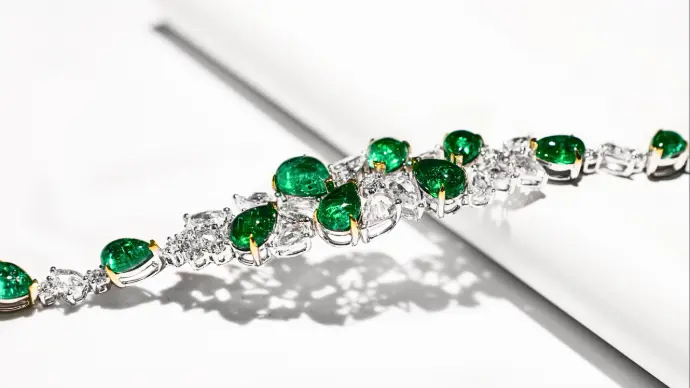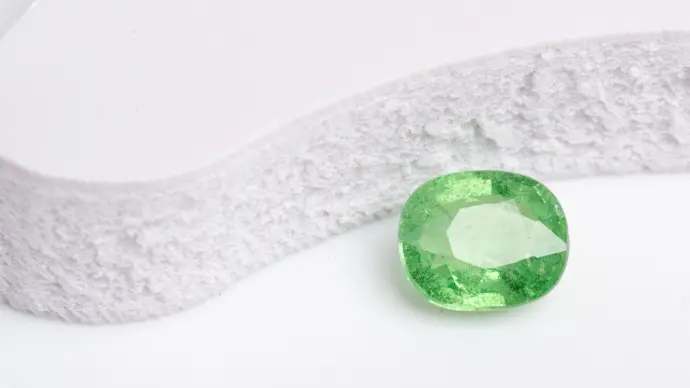You likely feel drawn to natural green gemstones—emeralds, jade, and more—for their rich, timeless beauty. But not all green stones are created equal. Instead of being natural, some green gemstones are treated to enhance color or clarity.
Knowing how to tell natural green gemstones from treated ones helps you protect your investment and buy with confidence. Natural, untreated gems usually show inclusions, natural growth patterns, and no artificial surface treatments. In contrast, treated stones may look clearer or more vibrant because of processes like heating, dyeing, or fracture filling. Recognizing these differences — and checking with a trusted lab report — gives you assurance of authenticity.
In this guide, we will discuss how you can identify natural and treated gemstones. You’ll know detection methods, what tests matter, and when to rely on lab certification.

Understanding Natural Green Gemstone Characteristics
Natural gemstones are exactly what they sound like. They are natural, not treated.
Natural green gemstones exhibit subtle color variations and depth. You will often see inclusions in untreated gemstones. They include tiny mineral specks, characteristic growth patterns, or natural fissures.
These features are not defects but a strong indicator of authenticity. Perfect clarity and uniform green tone under magnification often suggest the stone has been treated. However, natural gems can also have excellent clarity.
Here are the main characteristics of natural green gemstones that help you recognise them:
- Color variation: Natural stones often show subtle changes in hue, tone, and saturation rather than a perfectly even green.
- Inclusions: You’ll see tiny mineral crystals, fine fissures, or “jardin” patterns in emeralds. These are natural growth features, not flaws.
- Natural growth lines: Internal zoning or lines that reflect the gem’s slow crystal formation underground.
- No surface coatings: The color comes from within the crystal, not from an applied layer.
- Stable color: Genuine color doesn’t fade under normal light.
- Unique patterns: You will see that no two natural gems have the exact same internal features or color distribution.
- Natural refractive index: Measurable with a refractometer and matches the expected value for that gem species. However, RI testing generally specifies the gem species and confirms the authenticity. But this doesn’t always reveal a treated stone.
Understanding Treated Green Gemstones Methods
A treated green gemstone is one that has been subjected to a man-made process to increase its clarity, color, and overall appearance.
Treated gemstones are considered natural in origin (72% for low-heat treatment, more than 50% for high-temperature treatment). But there is no doubt that they get their state with help.
The following methods are used to treat the green gemstones to enhance their visual appeal.
- Heat treatment in emeralds: It changes hue and reduces visible inclusions. It’s stable but alters the stone’s natural state. Though heat treatment is common in green sapphire, topaz, rubies, etc., it is not very common in emerald.
- Dyeing in green gems: The process is frequent in green Beryl, Jade (lower-quality green Jadeite), and porous materials. This is not common in fine emerald. Dyes can fade or bleed if exposed to chemicals.
- Fracture-filling or oiling: The method uses oils or resins to mask cracks in emeralds. However, oiling is a standard practice in the industry– it doesn’t mean low-quality. But ultimately, it is considered a treatment.
How to Perform Treated Gemstone Identification
You can check for treatments yourself or get help from a professional jeweller:
- UV light gemstone inspection: Shine a UV lamp on the gem. Natural green gemstones like emeralds may often show little or no glow. Treated stones may glow differently because dyes or fillers react to the light.
- Magnification: Use a jeweller’s loupe or microscope. If you see color clumped in cracks or along edges, that’s a sign of dyeing. If you spot a rainbow-like “flash” inside cracks, it may be fracture-filled. However, natural “rainbow” interference can sometimes occur in unfilled fissures, so lab testing is best for confirmation.
- Treated vs natural color: A perfectly even, overly bright green may indicate color enhancement. Natural stones usually have gentle shifts in shade.
Lab Analysis of Gemstones and Certification Reports
Some treatments can’t be detected without advanced equipment. That’s where lab analysis of gemstones matters.
Reputable labs like GIA or IGI use spectroscopy, advanced microscopy, and chemical analysis to find enhancements. A gem certification report includes the gem type and treatment status. However, origin is also mentioned for emerald, ruby, or sapphire when determinable.
With a renowned lab report, you will easily find out if your to-be-picked green gem is treated or natural.
Look for clear gemstone treatment disclosure — reports should state the method used, such as “oiled,” “dyed,” or “heated.” In some cases, for accuracy, some lab reports use phrases like “Evidence of moderate oil” or “Evidence of heating,” and may also report “no evidence of treatment.”
This protects you from paying natural-stone prices for a treated gem.
Comparing Green Gemstone Detection Methods
Here is a quick overview of different green gemstone detection methods, whether it is natural or treated with costing ideas.
Test |
What It Detects |
Tools / Cost |
Reliability |
Refractive index testing |
Species, treatments |
Refractometer (med) |
High professional level |
UV light inspection |
Coatings, dyes |
UV lamp (low) |
Helpful initial indicator |
Magnification (loupe) |
Dye, fillers, and wear signs |
Loupe (low cost) |
Good for obvious cases |
Lab certificate |
Treatment, origin |
Lab report (higher) |
Definitive proof |
Final Thought
By using simple tools and insisting on lab-verified documentation, you can make a more informed judgment between Natural and Treated Green Gemstones. For lasting assurance, choose sellers who offer full transparency and certification.
Saratti stands out in offering transparency with every gemstone. Our heirloom-quality stones are certified by world-renowned laboratories like GRS, AGS, GIA, and GUILD Labs. For gems in the low to mid-range, each piece comes with a SARATTI certificate that clearly states whether it is natural or treated. With our clear and easy return and exchange policy, along with a lifetime warranty, you can be confident that your green gemstone will remain authentic and beautiful as promised.
